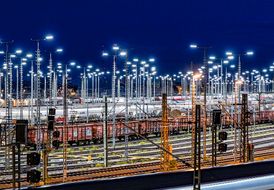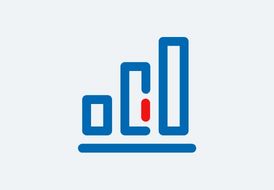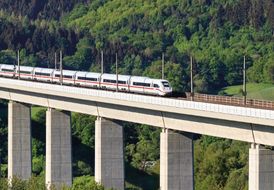Development in the year under review
- Recovery after Covid-19-related challenges – demand for traction energies increased significantly.
- Hedging strategy limits the impact of significant price increases on the energy procurement market.
- Increased capital expenditures in traction current supply.
- Supply reliability stable at a high level.
DB NETZE ENERGY | 2021 | 2020 | Change | 2019 | ||
absolute | % | |||||
Supply reliability (%) | 99.99 1) | 99.99 1) | – | – | 99.99 | |
Customer satisfaction (SI) | 79 | 77 | +2 | – | 78 | |
Customer satisfaction, traction current and diesel (SI) | 77 | 71 | +6 | – | 71 | |
Customer satisfaction, electricity and gas plus (intra-Group customers) (SI) | 80 | 76 | +4 | – | 78 | |
Customer satisfaction, electricity and gas plus (non-Group customers) (SI) | 80 | 85 | –5 | – | 86 | |
Traction current (16.7 Hz and direct current) (GWh) | 7,445 | 7,263 | +182 | +2.5 | 7,986 | |
Pass-through traction current (16.7 Hz) (GWh) | 2,281 | 1,985 | +296 | +14.9 | 1,566 | |
Stationary energy (50 Hz and 16.7 Hz) (GWh) | 14,070 | 14,063 | +7 | – | 14,932 | |
Diesel fuel (million l) | 389.3 | 385.7 | +3.6 | +0.9 | 410.6 | |
Total revenues (€ million) | 3,366 | 2,724 | +642 | +23.6 | 2,812 | |
External revenues (€ million) | 1,808 | 1,297 | +511 | +39.4 | 1,308 | |
EBITDA adjusted (€ million) | 254 | 91 | +163 | – | 128 | |
EBIT adjusted (€ million) | 169 | 5 | +164 | – | 43 | |
Gross capital expenditures (€ million) | 340 | 273 | +67 | +24.5 | 193 | |
Net capital expenditures (€ million) | 66 | 51 | +15 | +29.4 | 61 | |
Employees as of Dec 31 (FTE) | 1,900 | 1,861 | +39 | +2.1 | 1,772 | |
Annual average employees (FTE) | 1,892 | 1,821 | +71 | +3.9 | 1,751 | |
Employee satisfaction (SI) | – | 4.0 | – | – | – | |
Share of women as of Dec 31 (%) | 13.9 | 14.4 | –0.5 | – | 13.3 | |
Share of renewable energies in the DB traction current mix (%) | 62.4 | 61.4 | +1.0 | – | 60.1 | |
1) Preliminary figure (not rounded).
The high level of supply reliability was maintained.
Customer satisfaction was at a very high level. Across all product areas, customers are very satisfied with employee behavior, service quality and settlement. There were improvements in traction energy in particular, resulting from optimizations to the reporting and settlement processes compared to the previous year.
Volumes grew, primarily as a result of recovery effects after the pandemic-related decrease in the previous year:
- Traction current sales increased, mainly as a result of higher demand from intra-Group customers in long-distance passenger and freight transport. A shift in demand from non-Group customers to pass-through traction current curbed this development slightly.
- The traction energy passed-through for non-Group customers increased significantly. In addition to recovery effects, increased traffic and shifts away from full supply models also led to an increase.
- In stationary energy, electricity sales remained virtually unchanged. The decline in portfolio optimization measures on the energy market almost completely eliminated the recovery effects and growth of the private customer business.
- The increased demand for diesel fuels is due to intra-Group customers in regional and freight transport.
Economic development improved. The increases in revenues were only partly offset out by higher energy procurement expenses. The operating profit figures improved significantly.
The driver for these developments was noticeable income growth:
- Revenues increased significantly, due mainly to higher prices in energy trading and revenues from CO₂ certificates. Higher sales prices for diesel fuel and stationary energy also had an effect. Higher sales volumes and prices also led to an increase in revenues from traction current.
- Increase in other operating income (+36.8%/€ +28 million) resulted, among other things, from higher income from the release of provisions. In addition, income from technical services provided to internal and external customers also increased.
In terms of expenses, there were additional challenges related to the cost of materials, due in particular to the recovery in demand and price factors:
- Cost of materials increased significantly (+20.5%/€ +505 million). Increased sales volumes, price effects in energy trading and in CO₂ certificates as well as higher procurement prices led to an increase in energy procurement expenses.
- Personnel expenses (+8.2%/€ +11 million) increased as a result of a higher number of employees and collective bargaining agreements.
The remaining expense items remained almost unchanged:
- Other operating expenses (–3.8%/€ –5 million) declined slightly. In addition to fewer IT services, lower impairments on receivables in particular had a cost-reducing effect. This was countered by increased rental expenses and license costs for software.
- Depreciation (–1.2%/€ –1 million) decreased primarily due to the absence of negative one-time effects in the previous year.
Capital expenditures increased significantly as a result of an increased volume as part of the LuFVIII and increased capital expenditures in joint projects (requirement plan). Net capital expenditures also increased as a result of a one-time effect from the capitalization of a lease contract.
The number of employees increased slightly, primarily in order to implement the higher project volume arising from the LuFVIII and through insourcing IT services.
The share of women declined.
The share of renewable energies in the DB traction current mix in Germany continued to grow.



